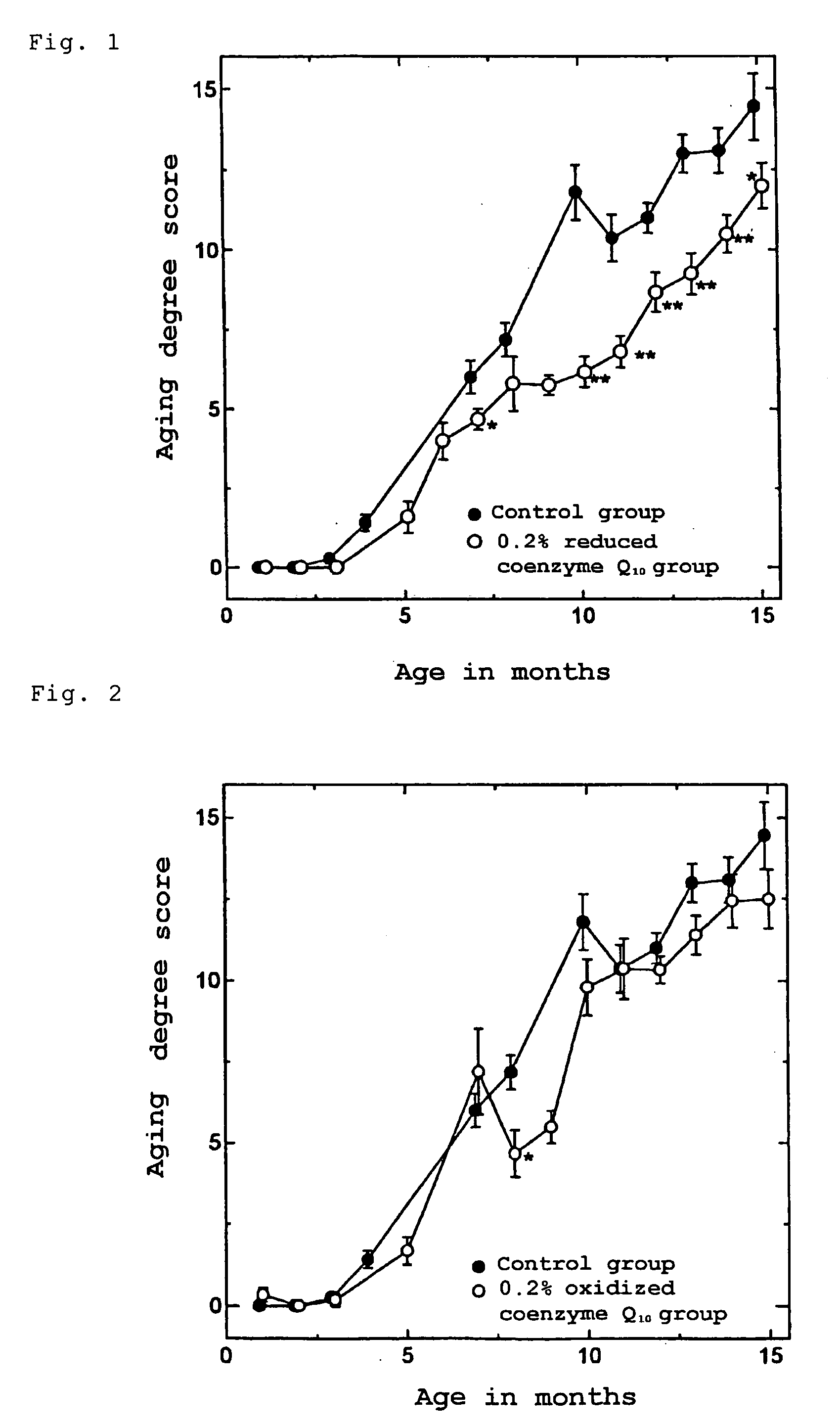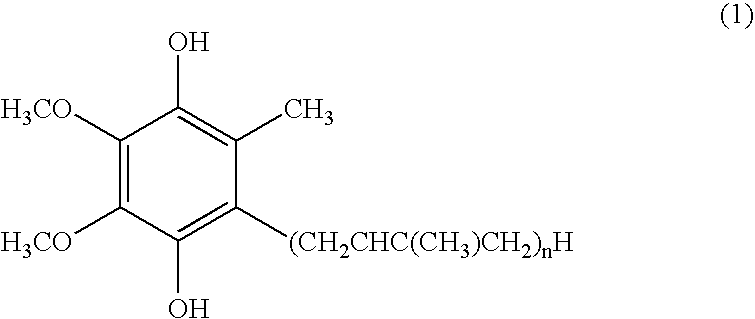Antiaging composition
a composition and anti-aging technology, applied in the field of composition, can solve the problems of insufficient analogy from a mere antioxidant activity, insufficient reduction of coenzyme q/sub>10, and inability to commercializ
- Summary
- Abstract
- Description
- Claims
- Application Information
AI Technical Summary
Benefits of technology
Problems solved by technology
Method used
Image
Examples
production example 1
Production of Reduced Coenzyme Q10
[0051] 100 g of oxidized coenzyme Q10 (purity 99.4%) and 60 g of L-ascorbic acid were added to 1,000 g of ethanol, and the mixture was subjected to the reduction reaction while stirring at 78° C. After the lapse of 30 hours, the mixture was cooled to 50° C. and, while maintaining that temperature, 330 g of ethanol and 70 g of water were added. This ethanol solution (containing 100 g of reduced coenzyme Q10) was cooled to 2° C. at a cooling rate of 10° C. / hour with stirring to give a white slurry. The slurry obtained was filtered under reduced pressure, the wet crystals were washed in sequence with cold ethanol, cold water and cold ethanol (the temperature of the cold solvents used being 2° C.), and the wet crystals were further dried under reduced pressure (20 to 40° C., 1 to 30 mmHg) to give 97 g of reduced coenzyme Q10 (containing about 1% of oxidized coenzyme Q10) as white dry crystals. All the operations other than drying under reduced pressure...
production example 2
Production of Reduced Coenzyme Q10
[0052] 100 g of oxidized coenzyme Q10 was dissolved in 1,000 g of heptane at 25° C. While stirring, the solution was gradually added with an aqueous solution prepared by dissolving 100 g of sodium dithionite (purity not lower than 75%) as a reducing agent in 1,000 ml of water, thus allowing the reduction reaction to proceed at pH 4 to 6 at 25° C. After the lapse of 2 hours, the aqueous phase was removed from the reaction mixture, and the heptane phase was washed with 1,000 g of a deaerated saturated aqueous solution of sodium chloride for six times. This heptane phase was subjected to solvent substitution under reduced pressure for preparing a 7% (w / w) ethanol solution of reduced coenzyme Q10 at 50° C. (the solution containing 100 g of reduced coenzyme Q10). 50 g of water was added to this ethanol solution, and the mixture was cooled to 2° C. at a cooling rate of 10° C. / hour while stirring to precipitate crystals. All the operations were carried ou...
example 1
Aging Preventing (Retarding) Effect in Aging-Accelerated Model Mice
[0053] Aging-accelerated model mice (SAMP1, 3-week-old females) were allowed free access to a feed (CE-2, product of CLEA Japan, Inc.) containing 0.2% reduced coenzyme Q10 (containing about 1% of oxidized coenzyme Q10) obtained in Production Example 1, and the aging degree of each mouse was quantified with time according to the aging degree score mentioned below. The dose of reduced coenzyme Q10 as estimated from the feed consumption and animal weight corresponded to about 150 to 250 mg / kg / day. A control group was given the feed alone (CE-2, product of CLEA Japan, Inc.).
[0054] The aging-accelerated model mice used were model mice discovered and bred at Kyoto University which develop the state of aging early and markedly. These mice show the state of aging quite similar to that of humans, and are useful model animals for in vivo testing for antiaging effects. The aging degree scoring system employed was the scoring ...
PUM
| Property | Measurement | Unit |
|---|---|---|
| retention time | aaaaa | aaaaa |
| retention time | aaaaa | aaaaa |
| temperature | aaaaa | aaaaa |
Abstract
Description
Claims
Application Information
 Login to View More
Login to View More - R&D
- Intellectual Property
- Life Sciences
- Materials
- Tech Scout
- Unparalleled Data Quality
- Higher Quality Content
- 60% Fewer Hallucinations
Browse by: Latest US Patents, China's latest patents, Technical Efficacy Thesaurus, Application Domain, Technology Topic, Popular Technical Reports.
© 2025 PatSnap. All rights reserved.Legal|Privacy policy|Modern Slavery Act Transparency Statement|Sitemap|About US| Contact US: help@patsnap.com



